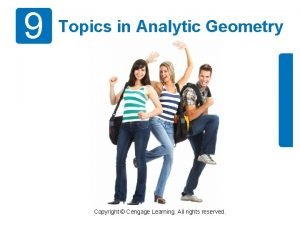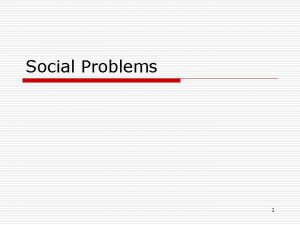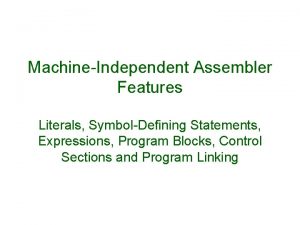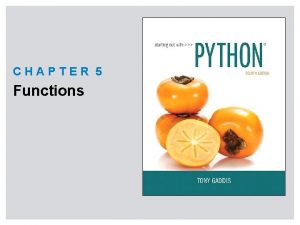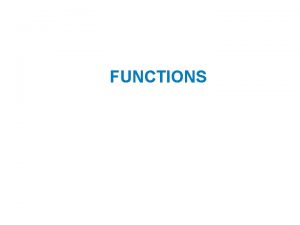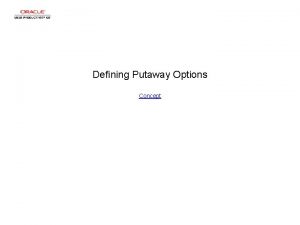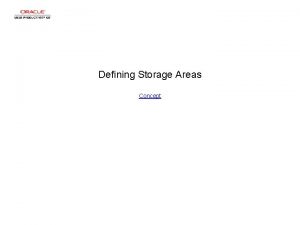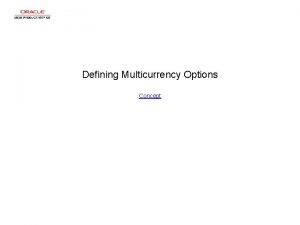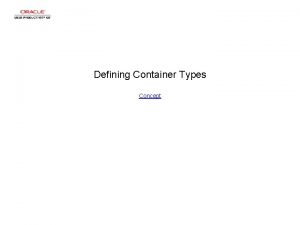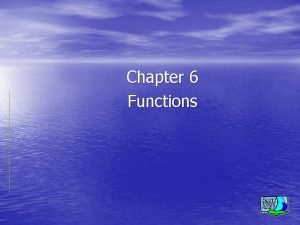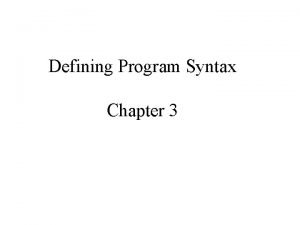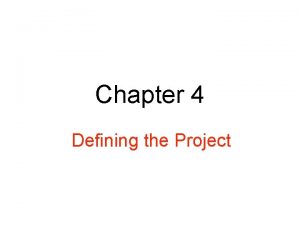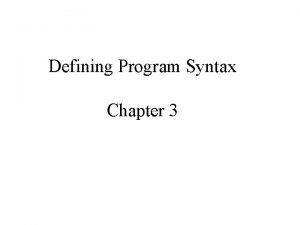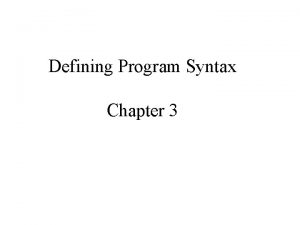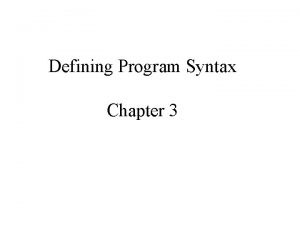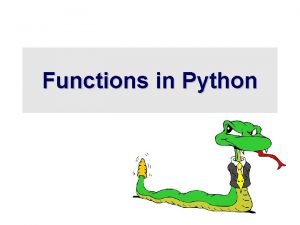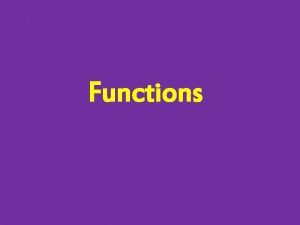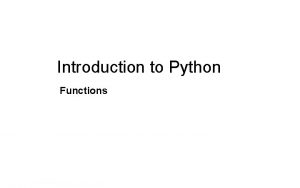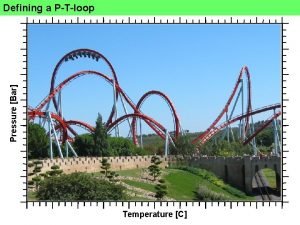CHAPTER 5 Functions Topics Introduction to Functions Defining



























- Slides: 27

CHAPTER 5 Functions

Topics • Introduction to Functions • Defining and Calling a Void Function • Designing a Program to Use Functions • Local Variables • Passing Arguments to Functions • Global Variables and Global Constants

Benefits of Modularizing a Program with Functions • The benefits of using functions include: ◦ Simpler code ◦ Code reuse • write the code once and call it multiple times ◦ Better testing and debugging • Can test and debug each function individually ◦ Faster development ◦ Easier facilitation of teamwork • Different team members can write different functions

Introduction to Functions • Examples of built-in functions: input, float, int, etc • Group of statements within a program that perform a specific custom task ◦ A task of a large program with multiple tasks • Functions can be executed in order to perform overall program task ◦ Known as divide and conquer approach • Modularized program: A large task or program is broken up into smaller tasks or functions


Types of Functions • A function can just execute statements or return a value to the function that called it • A void function ◦ Simply executes the statements it contains and then terminates • A value-returning function ◦ Executes the statements it contains then it returns a value back to the statement that called it • Ex: input, int, and float functions

Naming a Function ◦ It follows the same rules as variable naming ◦ Function name should be descriptive of the task carried out by the function ◦ Often includes a verb ◦ Cannot use key words as a function name ◦ Cannot contain spaces ◦ First character must be a letter or underscore ◦ All other characters must be a letter, number or underscore ◦ Uppercase and lowercase characters are distinct

Defining a Function ◦ Function must be defined before they are used ◦ Could be in beginning of program before main program starts ◦ Function header: first line of function – Includes keyword def and function name, followed by parentheses and colon ◦ Block: set of statements that belong together as a group – Example: the statements included in a function ◦ Function definition template def function_name(): statement

Definition and Calling Function Example # This program demonstrates a void function. # First, we define a function named message. # Notice statements in function are indented since that shows # where the function statements begin and end # Statements in main are not indented def message(): print('I am Arthur') print('King of the Britons') # Main program # Call the message function. print (“Hello”) message() Output Hello I am Arthur King of the Britons

Example Function ◦ Notice that the function is defined before it is used ◦ The first statement to be executed is not in the function even though it is listed first ◦ The first statement to be executed is in the main program ◦ Then the function is executed which executes the statements in the function

Calling a Function within Function • You can call one function within another function • You cannot call the main program • This allows you to break up the code to be more readable and repeat things with custom values

Designing a Program to Use Functions • In a flowchart, a function call is shown as a rectangle with vertical bars on each side ◦ Function name written in the symbol ◦ Typically draw separate flow chart for each function in the program • End terminal symbol usually reads Return • Top-down design: technique for breaking algorithm into functions

Function Flowchart

Variable Types ◦ Global – value can be seen in all functions ◦ Local – value can only be seen in function that created it ◦ Parameter – used when passing a value to a function

Local Variables • Assigned a value inside a function ◦ Belongs to the function in which it was created • Only statements inside that function can access it • Error will be generated if accessed from outside the function • Scope: the part of a program that recognizes a variable ◦ For local variable – only in function that created it

Variables Definition and Usage • Define local variables first • Cannot be accessed by statements inside its function before it is created just like before • Different functions may have local variables with the same name ◦ Each function does not see the other function’s local variables ◦ Otherwise there would be confusion between functions

Problem With Local Variable # Definition of the name function. def name(): get_name() print('Hello', name) # This causes an error! # Definition of the get_name function. def get_name(): name = input('Enter your name: ') # Call the name function. name()

Arguments • Argument: value (data) that is sent into a function ◦ ◦ Function can use argument in calculations Argument is placed in parentheses after function name Received by parameter in function If variable is used, its value cannot be changed ◦ Only value is sent to function

Passing Arguments to Functions Example

Parameter Variable • Assigned the value of an argument when the function is called ◦ The parameter and the argument have same value ◦ General format: ◦ def function_name(parameter): ◦ Scope of a parameter: only the function in which the parameter is used

Parameter In Use

Passing Multiple Arguments • Python allows writing a function that accepts multiple arguments • Parameter list items are separated by comma • Arguments are passed by position to corresponding parameters ◦ First parameter receives value of first argument, second parameter receives value of second argument, etc.

Passing Multiple Arguments Example

Multiple Parameters In Action # multiple_args. py # This program demonstrates a function that accepts two arguments. def main(): print('The sum of 12 and 45 is') show_sum(12, 45) # The show_sum function accepts two arguments and displays their sum. def show_sum(num 1, num 2): result = num 1 + num 2 print(result) # Call the main function. main()

Making Changes to Parameters • Changes made to a parameter value within the function do not affect the argument ◦ Known as pass by value ◦ Provides a way for unidirectional communication between one function and another function • Calling function can communicate with called function

Making Changes to Parameters In Use

Making Changes to Parameters In Use • Figure 5 -18 ◦ The value variable passed to the change_me function cannot be changed by it
 Defining non defining clause
Defining non defining clause Relative clauses defining and non defining
Relative clauses defining and non defining Relative clauses defining and non defining
Relative clauses defining and non defining Defining and non defining relative clauses in telugu
Defining and non defining relative clauses in telugu Where kullanımı relative clauses
Where kullanımı relative clauses Defining and non defining relative clause
Defining and non defining relative clause Chapter 9 topics in analytic geometry
Chapter 9 topics in analytic geometry Definition of intelligence
Definition of intelligence The defining moment in greek history is the wars.
The defining moment in greek history is the wars. Four traits of chordates
Four traits of chordates Definition of textbook
Definition of textbook Lord capulet defining quotes
Lord capulet defining quotes Lady montague defining quotes
Lady montague defining quotes Non-defining relative clauses as sentence modifiers
Non-defining relative clauses as sentence modifiers Situational poverty definition
Situational poverty definition Program block and control section
Program block and control section Defining and evaluating a logarithmic function
Defining and evaluating a logarithmic function Definition of leadership and management
Definition of leadership and management Defining the research problem
Defining the research problem Defining research objectives
Defining research objectives Non defining relatives clauses
Non defining relatives clauses Result approach in measuring performance
Result approach in measuring performance Defining marketing for the 21st century
Defining marketing for the 21st century Broad problem area example
Broad problem area example Nesting member function
Nesting member function Approaches to measuring performance
Approaches to measuring performance Abell's framework for defining the business
Abell's framework for defining the business The new marketing realities
The new marketing realities






